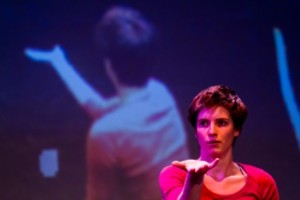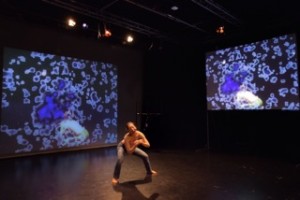Guy Dartnell is a Performance Artist and Film Maker with an interest in the links between voice, movement, and emotion, which he explores through his workshops. Here Guy explains the thinking behind the ‘voicemotion’ events he runs, the next of which will take place in Hastings on 19 October 2013.
Voicemotion aims to blend voice and movement together and through this enable people to access and embody emotional qualities in themselves. The work is derived from many influences – artistic, therapeutic and spiritual – and from study, research and collaborations I’ve undertaken over thirty years. It’s particularly influenced by the work of the Roy Hart Theatre and in keeping with their method, it has as much a self-developmental based aspect to it as it does a performance training based one.
I don’t do much technical analysis of voice and movement production, I work more on developing instinct and self-observation. On the voice level no words are used only sounds. The fusion of voice and movement is achieved by using the energy of the emotions as both the fuel and glue driving and forging the vocal-physical dynamic. Via a series of group and individual processes, people explore and express the rhythms, patterns, peaks and troughs inherent within the emotional qualities that emerge within and around them. The emphasis is on emotional ebb and flow – that if one can be open to one’s feelings and not stand in their way, then the voice and the body flow naturally and easily together – the feeling aspect spontaneously informing the body what to do, side-stepping the more thinking and instructional aspects of the individual, which tend to ‘get in the way’.
I look at the speed, frequency and pitch of emotions, helping my participants to understand how these things can help or hinder emotional expression – how although somebody may feel something, they may find difficulty in expressing it, because of the particular flow and quality of voice or physicality they have adopted to express it. The adopted mode may be completely at odds to the nature of the feeling itself and may be acting unconsciously, being part of some chronic misalignment between feeling and expression going back even to childhood.
For instance, we look at how some emotional qualities require the lower reaches of the voice to access them, some the higher. How as a consequence of this the expression of certain emotional qualities may be denied or limited by the particular conditioning people have experienced throughout their lives (some collective, some self-imposed) that have reinforced certain vocal and physical stereotypes attached to their gender. We look at how some emotional qualities are legato or staccato in nature and that to ‘take a ride’ on your emotions as they emerge, you may need to adjust the speed and frequency at which you are willing to express yourself, so that you can channel the emotion rather than block it or struggle with it.
To help people change this we spend time formally exploring different areas of sound/movement quality, getting people to try and allow their voices and bodies to operate in unison within these qualities. In this way they start to get an understanding of which qualities they most feel at home with and which they avoid, at the same time providing them with the means to start changing their relationship to those qualities, developing their connectedness and expressiveness in those areas which they are weakest, while broadening their existing strengths.
I work on the concept of outside and inside being aspects of the same thing – feeling something inside and transforming that into a vocal/physical quality on the outside, or taking a vocal/physical quality from the outside and allowing that to develop further and seep inwards, so that the emotional quality behind it can be discovered. This means that we do a lot of passing and sharing of emotions from person to person, to encourage people to re-discover qualities of themselves that they may have lost through their own habitual patterns of voice/body use – qualities that may be more immediately apparent in other people. Of course this also has the paradoxical effect of heightening people’s awareness of their own particular qualities too, through having them reflected back by others.
One of the consequences of the work is to make being emotional the norm within the room, thus rendering the expression of emotion ‘bland’. This takes away the attendant notion that expressing emotion is a ‘big deal’, and within this culture and atmosphere of commonplace emotional behaviour, individuals and the group find it easier to take risks. Because of this, it is as if the group is able to access what I sometimes call a collective ‘slush fund of emotions’ that seems to exist like a well, waiting to be drawn from and gushing forth in the service of anyone who wishes to drink from it.
I do not look at the content of emotions. I don’t seek to find out where the emotions people are expressing come from – for instance why they are angry or sad at any moment in time, or what the history of those feelings might be. People simply share in the commonality of their ability to experience and express emotions and witness them in others. If you like I am more concerned with people exploring how to ‘be’ an emotion than express it. There is a difference I feel – one is more universal than the other.
Because of this participants are encouraged and aided to reach the extremes of any emotional quality they inhabit, paradoxically discovering that at the furthest reaches of one emotion are the beginnings of another, possibly totally different in nature. In everyday life emotions are often short lived, constantly changing in the dance and dialogue created by people reacting and responding to one another and themselves. In the workshop we try to give space so that any particular emotion can have longer to live, allowing people to experience what the nature of any emotion could be outside the limitations and conventions of normal everyday interaction.
Finally the work is about ‘play’ and spontaneity. The improvisational element of the work is important; because the sense of delving into the unknown creates immediate and strong emotional impulses/states that the participants can work with. The improvisations, which are ‘guided’ involve transforming these impulses and states into patterns and rhythms, ‘playing’ with them and developing them into a “game” that could be shared with an audience, though not necessarily so. The further developments of the work depends on the needs of whatever groups or individuals I am working with, but in the past has involved extending Voicemotion to work on text, dance, music, fooling, video and physical and learning disabilities. One of my most recent collaborations Shaping Sounds 2 was with a deaf choreographer Chisato Minamimura and acoustic specialist Dr. Dirk Püschel, using visual acoustic technology form the aircraft and motor industries.A documentary about this work is available here.


